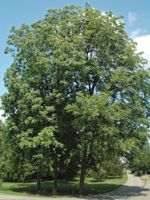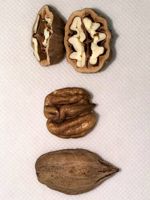Mon-Fri 9am - 5pm Mountain time
Hardy Pecan vs Burton Hican
Carya illinoinensis
Carya ovata x illinoinensis Burton
NOT AVAILABLE THIS SEASON - MIGHT RETURN
NOT AVAILABLE THIS SEASON - MIGHT RETURN
Hardy Pecan trees are known for their edible nuts that ripen in late autumn. They can be eaten raw or cooked and can be used in a wide range of baked goods. If stored properly in a cool, dry location, they can be kept for up to 6 months in their shell. Trees tend to bear nuts at maturity, which occurs around 6 -10 years. The size and form of this tree also makes it a great shade or feature tree for your landscape.
For nut production, it is recommended that at least 2-3 are planted so that cross pollination can occur. In colder areas it is likely that nut production will be limited, especially in locations with late frosts and shorter growing seasons.
If exposed to high winds, Hardy Pecan is known to lose branches, but these can be used as firewood, or to smoke foods with a hickory flavour. Finding seed or seedlings of this tree is rare in Canada.
Note: plant this tree once. It will not respond well to transplanting.
Burton Hican is a rare cross between Shagbark Hickory and Pecan. Most Hickory x Pecan hybrids are not reliable producers but the Burton Hican produces large crops annually (in warmer climates). The medium sized nuts fall in between the Pecan and Hickory and are known for having a great flavor. They are well suited to fresh eating, cooking, and baking with a good storage life.
Hicans will carry features from both species. The Hickory influence causes earlier ripening times while the taste and productivity come from the Pecan. The Pecan genetics also cause the nuts to have a thinner shell that is easier to crack and the pecan-like shape makes kernel removal easier.
The Burton Hican is generally considered self pollinating but having a second variety for cross pollination will increase nut production. They have been known to cross pollinate with other Hicans, Shagbark Hickory, and some Pecans. Nut production is expected after 7-10 years.
Note: Plant this tree once. Due to its large tap root transplanting is not recommended.

